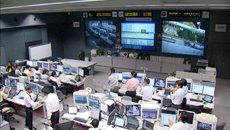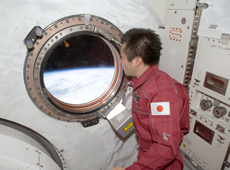Q. Please describe the work of the Flight Director?

Mission Control Room
At the Tsukuba Space Center, there is a Mission Control Room for the Japanese Experiment Module "Kibo". Specially trained operators work there around the clock, in three shifts a day, 365 days a year. Their job is to monitor and control Kibo's systems and experiment devices, to conduct experiments, and to perform maintenance when necessary, while communicating with the astronauts on the International Space Station (ISS). The person in charge of this operation is the JAXA Flight Director, or J-FLIGHT.
Astronaut Koichi Wakata was on the ISS from March to July 2009, as a crew member of ISS Expeditions 18, 19 and 20. I was in charge of Expeditions 19 and 20, starting in April 2009, so I served as Flight Director for most of astronaut Wakata's mission.
Q. What are your thoughts on astronaut Wakata's long-term mission?

Astronaut Naoko Yamazaki served as J-COM for the 1J/A mission
During astronaut Wakata's four and half months on the ISS, we performed various experiments while also completing the final stage of the installation of Kibo, which was one of the most important goals. I'm very pleased that we were able to finish Kibo and all our other scheduled projects during his mission. I feel everything was finished very quickly, and, to be honest, I wish astronaut Wakata's stay on the ISS could have been a little longer. I also wish I could have worked with him after Kibo's completion on projects such as experiments on the newly attached Exposed Facility, or docking operations with the H-II Transfer Vehicle (HTV).
When astronaut Wakata got to the ISS, it was being operated by only three astronauts, so for a while he had a very busy life. It was only when the Soyuz docked with the ISS in May 2009 that the team was increased to six. After that, astronaut Wakata had a lot more time on his hands, and he often called us to ask, "Is there any more work to do? Is there any trouble?" We were very grateful to him for communicating with us frequently through the space station's IP telephone or by e-mail.
These conversations showed us how important good communication is to smooth operation of the ISS. Normally, the only person who communicates with the astronauts in orbit is the operator in charge of communication, known as the JEM Communicator, or J-COM. We pass on our orders and messages to the J-COM, who summarizes them and puts them through to the ISS. The conversation language has to be English, so that NASA and the rest of the international partners' control teams can also understand. Astronaut Wakata often contacted us by IP telephone or email in Japanese. That allowed us to communicate more precisely, which in turn helped us understand the conditions in orbit as well as filling him in on what was happening on our end.
In addition, when NASA decided to postpone for a month the launch of space shuttle mission STS-127(2J/A), which was going to be astronaut Wakata's return flight, he told us, "I'll do whatever I can do while I'm here, so please plan some operations I can do for the next month." So, we were able to ask him to perform some additional maintenance and experiments, which we greatly appreciated. Thus, good communication with the astronauts in orbit allowed us to work together very well, and I think that in part led to the success of this mission.
Q. How did you feel when the installation of the Kibo module was finally completed?

The Mission Control Room at the time of Kibo's completion
The ISS project has had a long and complicated history, and the space shuttle accident in 2003 had made the construction of Kibo a longer journey than we had anticipated. So my feeling was simply, "We are here at last, and I'm thrilled." I had been working on ISS-related projects since I joined NASDA [now part of JAXA] in 1997, so I was really happy. When Kibo was completed, 2J/A Lead Flight Director Masao Nakai was in charge at the Mission Control Room, and we had to check system functions right away, so we actually didn't have time to get emotional. The Mission Control Room raised the roof with applause and cries of "We did it!", but we kept working and moved on to preparations for the next operation in a rather straightforward manner.
Q. What specifically impressed you during astronaut Wakata's mission?

Astronaut Koichi Wakata looking at Earth through the window of Kibo (Courtesy of NASA)
We got used to having audio communication with astronaut Wakata everyday, but after a while he told us, "After so long, I want to see everyone's face." So we planned an Internet video meeting during his free time. That was something that impressed me. We all felt that astronaut Wakata cared about the ground team - not just the members of the mission control team, but also all the related personnel, including trainers, medical team members, etc. I think the motivation of the ground crew got a big boost from that.
We also had an Internet video meeting to celebrate astronaut Wakata's 100th day in space. More than 100 people got together in the Mission Control Room for that. Since astronaut Wakata said he was missing Japanese-style breakfasts, one of the operators cooked up rice and miso soup for breakfast and sent the images to the ISS, which made for a very heart-warming anniversary. Seeing each other's faces in addition to normal voice communication helped us shorten the distance to the ISS crew.
In addition, the beautiful images of Earth captured through Kibo's two windows were very impressive. The view has since been partially blocked by Kibo's Exposed Facility and other devices, but while astronaut Wakata was on the ISS, Earth could be clearly observed, and he often sent us these beautiful images. When I was on the Kibo development team, I was in charge of the windows. So whenever I saw these images, the windows were the first thing I looked at. I was really glad that Kibo had them.
Q. How does JAXA collaborate with NASA?
NASA controls the overall operation of the ISS. The Mission Control Center in Japan monitors the system devices and experiment equipment on Kibo, as well as the ground facilities at the Tsukuba Space Center, and keeps NASA informed. We tell each other, "Our conditions are like this at the moment and we are going to do this and that next." Each operator also works together with NASA when adjusting the various devices. Specifically, when we carry out operations using NASA's devices or need NASA's support, or when our operations affect other partner countries, we have to coordinate with NASA before making any changes.
